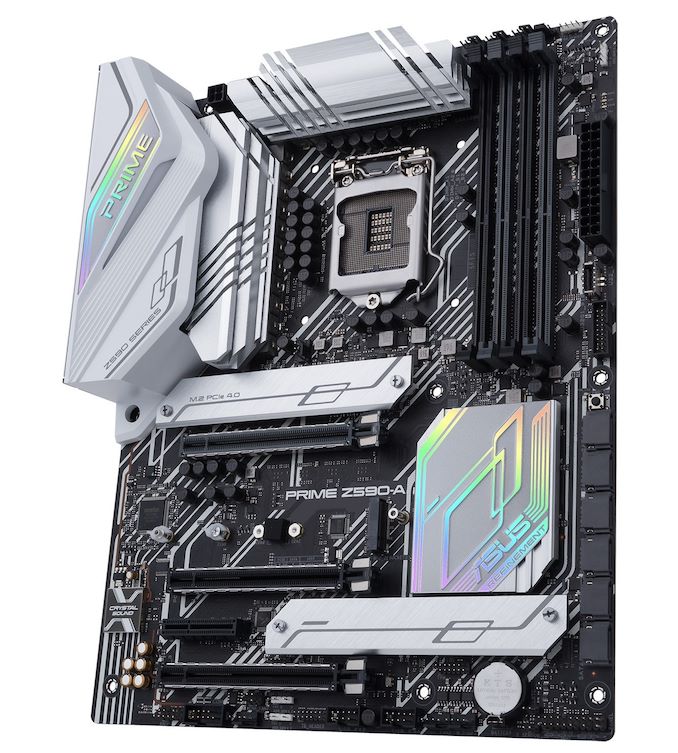The Intel Z590 Motherboard Overview: 50+ Motherboards Detailed
by Gavin Bonshor on January 19, 2021 10:15 AM ESTASUS Prime Z590-A
ASUS's Prime series of models have been around for multiple generations, and it's designed to offer users high-performance, with elegantly light-themed aesthetics. The ASUS Prime Z590-A ticks both of these boxes with its stunning aluminum themed design, with holographic styling on the rear panel cover and chipset heatsink. ASUS is advertising a 16-phase (14+2) power delivery and includes three M.2 slots.
The Prime Z590-A includes three full-length PCIe slots, with the top two operating at PCIe 4.0 x16 and x8/x8, with one operating at PCIe 3.0 x4. In between the two full-length slots at the bottom is a half-length PCIe 3.0 x4 slot. For storage, the board has one PCIe 4.0 x4 M.2 slot, with two PCIe 3.0 x4/SATA M.2 slots, and six right-angled SATA ports with support for RAID 0, 1, 5, and 10 arrays. Only two out of three of the M.2 slots include a heatsink, with the middle slot reliant on good passive airflow. Prime by name, Prime by nature, as it includes a 14+2 phase power delivery with DrMOS power stages, with a large silver power delivery heatsinks and a pair of 12 V ATX CPU power inputs, one 8-pin and one 4-pin.
ASUS has included plenty of connectivity options, including a USB 3.2 G2x2 Type-C, one USB 3.2 G2 Type-C, three USB 3.2 G2 Type-A, and four USB 2.0 ports. Networking options are limited to an Intel I225-V 2.5 GbE controller, while an unspecified HD audio codec powers the five 3.5 mm audio jacks and S/PDIF optical output. Users looking to benefit from Intel's integrated HD graphics can do so with a pair of video outputs, including one DisplayPort and one HDMI.
The ASUS Prime Z590-A looks set to cost $336, which is where mid-ranged Z590 models are expected to sit. It offers a variety of features and premium controllers, including three M.2 slots, USB 3.2 G2x2 Type-C, and an Intel 2.5 GbE controller. It's not a bad price, but pricing between the time of writing and release could differ slightly.












88 Comments
View All Comments
lmcd - Tuesday, January 19, 2021 - link
8 cores is plenty for this generation of memory bandwidth. The problem is that Intel's next gen will have "16" processors where 8 are full cores, while AMD will have a full 16 cores with all that bandwidth. This generation, Intel is competitive but late.rahvin - Wednesday, January 20, 2021 - link
Is this an attempt to be funny?pman6 - Tuesday, January 19, 2021 - link
meh. show me the $80 b560 boards.this is overkill for me.
Geef - Wednesday, January 20, 2021 - link
Why is Intel always behind the game with memory speeds? 3200 is just a basic speed nowadays. Its great if your running CAS 14 chips but not many are. Why haven't they set a speed up to 4000 or 5000? They can keep XMP going just fine but wouldn't it be better to have systems automatically go that fast if they can?Deicidium369 - Wednesday, January 20, 2021 - link
JEDEC tops out at 3200 - the fastest OFFICIAL speed it 3200. I have Gskill DDR4 4133 on my Gigabyte Z390 / i9900Kand JEDEC speeds are the same for AMD and Intel
Duncan Macdonald - Wednesday, January 20, 2021 - link
For most games the 5800x is the sweet spot due to only having one CPU chiplet so no communication between chiplets. The 5900 and 5950 with two chiplets lose on many games due to the cost of inter chiplet communications exceeding the benefits from the extra cores.The 5900 and 5950 are best in programs that can make good use of all the cores (eg some video editing programs). For any game player with a 5900 or 5950, it might well be possible to get higher game performance by limiting Windows to only the first chiplet (using the numproc boot parameter).
Makaveli - Wednesday, January 20, 2021 - link
I agree with you however the 5800X is really overpriced right now. So when you only have to pay abit more for the 5900X its looks like a far better deal. I think once Rocket lake is out we should see a price correction on the 5800X so the time to buy those will be in March.yeeeeman - Wednesday, January 20, 2021 - link
This....this is wasted resources IMO. There was no need to make another platform on 14nm when they have the 10th gen which is just fine. I mean, the 10900k/10700k are great CPUs still, even compared to 5000 Ryzen series, so I don't know...they should've focused the efforts on bringing Alder Lake and its successor platforms forward.Hope Pat will make a bit of order here and make the schedules and ambitions of Intel a bit more daring, cause Bob just...milked it like there is no tomorrow. Refreshes after refreshes and refreshes.
Makaveli - Wednesday, January 20, 2021 - link
That's what happens when you have a finance guy running the company he is just going to keep the wheels turning and not be aggressive. The new guy is an engineer and I believe he will push the pace which is what Intel needs now.Oxford Guy - Thursday, January 21, 2021 - link
Well, the world really needed a stack of 15 boards from just one motherboard company, too.